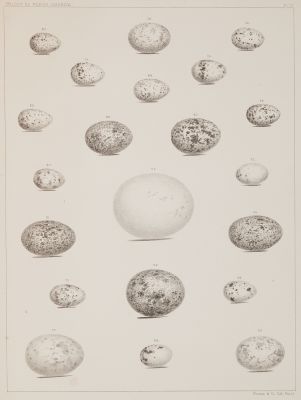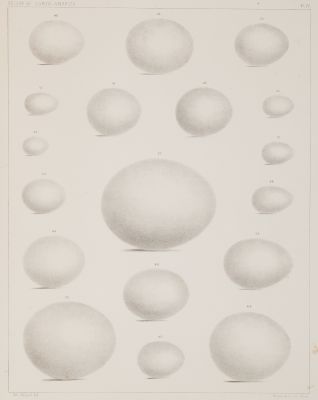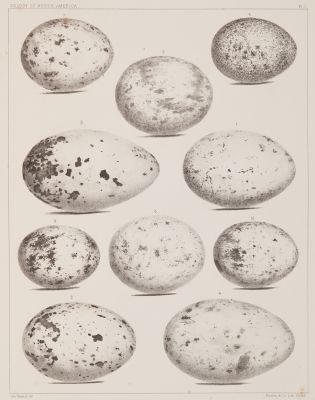
Title
Plate IArtist
Bradford, Lodowick (American, 1820-1885)Publication
North American Oology, part I: Raptores and FissirostresDate
1856Process
Lithograph (from photograph)Image Size
24 x 18.3 cm
Ingenious application of photography to the aid of lithography has given valuable results that could have been reached by no other means…The illustrations… are the most perfect representations of eggs that have ever yet been established. Thomas M. Brewer, April 1857⠀
⠀
Photolithography was the first of the new technologies to find a niche in the marketplace, emerging as a practical reproduction process simultaneously in the United States and Europe during the 1850s and ’60s. It depended upon a specially prepared lithographic stone that could receive a photographic image—either through a direct transfer process or through exposure to a negative—upon its light-sensitive surface. This image could retain a greasy printer’s ink and be printed like any other lithographic stone. Almost immediately, the process proved useful as an inexpensive method of reproducing maps, for it allowed hand-drawn maps to be quickly photographed and reproduced without being redrawn for an engraving plate. In fact, the grainy surface of the lithographic stone was actually Better suited for the reproduction of line drawings than for the continuous tone imagery of a photograph. Yet beginning with Thomas M. Brewer’s work on bird eggs, North American Oology, Part I: Raptores and, Fissirostres, published in 1857, the process also found limited use as a method for reproducing photographs in American scientific texts. Its more popular uses lagged far behind; the first United States newspaper to use the process was the New York Daily Graphic in 1873. [1]
References
[1] Sandweiss Martha A. 2002. Print the Legend : Photography and the American West. New Haven: Yale University Press. p. 290
Hanson, David Checklist of photomechanical processes and printing 1825-1910, 2017 p. 25








